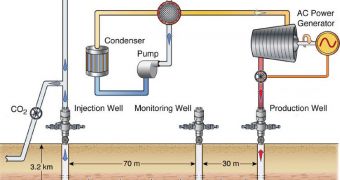Researchers at the US Department of Energy's (DOE) Lawrence Berkeley National Laboratory (Berkeley Lab) announce the development of a new source of clean, domestic energy, which they plant to put through the test next year.
If everything goes well, then the United States will have a new method of producing electricity at its disposal, an approach that would also contribute to reducing the impact other production techniques have on the environment.
What the Berkeley Lab team developed is a way of creating electrical current from Earth’s heat, by using carbon dioxide (CO2). The dangerous greenhouse gas is currently being emitted in bulk from power plants that use fossil fuels.
According to the research team, the first test instruments will be place in a field located in Cranfield, Mississippi, in early 2012. They will be built into shipping containers, and their role would be to test and see whether the technological process the group developed works or not.
While producing electricity in a renewable, environmentally-neutral manner, the new approach would also contribute considerably to removing global-warming causing carbon dioxide from the atmosphere.
One way to go about doing this is to store the dangerous gas underground. The new approach – developed with funds from the DOE – also proposes a mechanism for storing CO2. This component of the project will also be tested next year.
“This is the first project intended to convert geothermally-heated CO2 into useful electricity,” explains Berkeley Lab Earth Sciences Division mechanical engineer Barry Freifeld, the leader of the research.
He explains that technique relies on injecting CO2 to a depth of more than 3.2 kilometers, into a layer of Earth's crust that is heated to an average temperature of about 125 degrees Celsius. When placed in these environmental conditions, the gas enters a supercritical state.
What this means is that it exists as both liquid and gas at the same time. After the conversion occurs, the chemical is pulled back to the surface, and then fed in a turbine capable of removing heat, and turning it into electricity.
After this is done, the carbon dioxide is forced into the ground again, and the cycle begins anew. As the time passes, more and more of the stuff will remain trapped in the ground, and new amounts will be added to keep the system running.
“Carbon storage takes a lot of power – large pumps and compressors are needed. We may be able to bring down its costs by generating electricity on the side,” Freifeld concludes.

 14 DAY TRIAL //
14 DAY TRIAL //